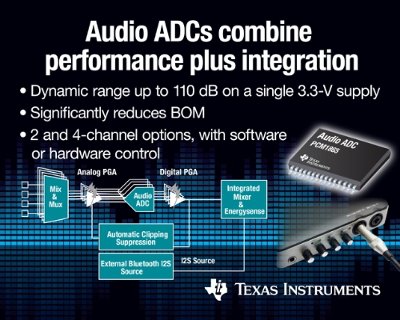
Texas Instruments (TI) today introduced a family of six high-performance audio analog-to-digital converters (ADCs).
Featuring a dynamic range as high as 110 dB, the devices in the PCM1865 family integrate features typically found in portable audio codecs, while also giving designers a level of performance previously found only in single-function, professional audio ADCs.
Powered by a single 3.3-V supply, the PCM1865 audio ADC removes the traditional requirement for a dedicated analog 5-V rail, making smaller, more efficient products possible.
Each device in the new family solves many system-level design headaches, including hum and ground noise, input-signal level sensitivity, and attenuation, all with a single device.
This integration is particularly beneficial for end equipment like personal computers; sound bars; audio docks; Bluetooth ® speakers; video-security systems; and automotive infotainment equipment including after-market head units, amplifiers, and active noise-cancellation systems.
Key benefits of the PCM1865 family: Design flexibility: The PCM1865 family consists of six pin-to-pin compatible devices offering two- and four-channel options, with software- and hardware-controlled variants.
High dynamic range: Three of the six devices in the PCM1865 family can achieve up to 110dB performance. No other audio ADCs on the market can achieve a performance level of 110dB with a single 3.3-V power supply.
Improves signal-to-noise ratio (SNR): With direct, high-voltage 2.1-VRMS support, the devices optimize audio quality and allow for a higher SNR.
Additionally, the software-controlled devices’ automatic clipping-suppression feature helps designers optimize input sensitivity for maximum SNR.
Source: www.ti.com
